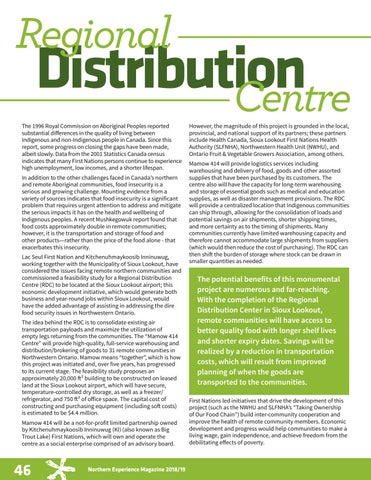Regional
Distribution Centre
The 1996 Royal Commission on Aboriginal Peoples reported substantial differences in the quality of living between Indigenous and non-Indigenous people in Canada. Since this report, some progress on closing the gaps have been made, albeit slowly. Data from the 2001 Statistics Canada census indicates that many First Nations persons continue to experience high unemployment, low incomes, and a shorter lifespan. In addition to the other challenges faced in Canada’s northern and remote Aboriginal communities, food insecurity is a serious and growing challenge. Mounting evidence from a variety of sources indicates that food insecurity is a significant problem that requires urgent attention to address and mitigate the serious impacts it has on the health and wellbeing of Indigenous peoples. A recent Mushkegowuk report found that food costs approximately double in remote communities; however, it is the transportation and storage of food and other products—rather than the price of the food alone - that exacerbates this insecurity. Lac Seul First Nation and Kitchenuhmaykoosib Inninuwug, working together with the Municipality of Sioux Lookout, have considered the issues facing remote northern communities and commissioned a feasibility study for a Regional Distribution Centre (RDC) to be located at the Sioux Lookout airport; this economic development initiative, which would generate both business and year-round jobs within Sioux Lookout, would have the added advantage of assisting in addressing the dire food security issues in Northwestern Ontario. The idea behind the RDC is to consolidate existing air transportation payloads and maximize the utilization of empty legs returning from the communities. The “Mamow 414 Centre” will provide high-quality, full-service warehousing and distribution/brokering of goods to 31 remote communities in Northwestern Ontario. Mamow means “together”, which is how this project was initiated and, over five years, has progressed to its current stage. The feasibility study proposes an approximately 20,000 ft² building to be constructed on leased land at the Sioux Lookout airport, which will have secure, temperature-controlled dry storage, as well as a freezer/ refrigerator, and 750 ft² of office space. The capital cost of constructing and purchasing equipment (including soft costs) is estimated to be $4.4 million. Mamow 414 will be a not-for-profit limited partnership owned by Kitchenuhmaykoosib Inninuwug (KI) (also known as Big Trout Lake) First Nations, which will own and operate the centre as a social enterprise comprised of an advisory board.
46
Northern Experience Magazine 2018/19
However, the magnitude of this project is grounded in the local, provincial, and national support of its partners; these partners include Health Canada, Sioux Lookout First Nations Health Authority (SLFNHA), Northwestern Health Unit (NWHU), and Ontario Fruit & Vegetable Growers Association, among others.
Mamow 414 will provide logistics services including warehousing and delivery of food, goods and other assorted supplies that have been purchased by its customers. The centre also will have the capacity for long-term warehousing and storage of essential goods such as medical and education supplies, as well as disaster management provisions. The RDC will provide a centralized location that Indigenous communities can ship through, allowing for the consolidation of loads and potential savings on air shipments, shorter shipping times, and more certainty as to the timing of shipments. Many communities currently have limited warehousing capacity and therefore cannot accommodate large shipments from suppliers (which would then reduce the cost of purchasing). The RDC can then shift the burden of storage where stock can be drawn in smaller quantities as needed.
The potential benefits of this monumental project are numerous and far-reaching. With the completion of the Regional Distribution Center in Sioux Lookout, remote communities will have access to better quality food with longer shelf lives and shorter expiry dates. Savings will be realized by a reduction in transportation costs, which will result from improved planning of when the goods are transported to the communities. First Nations led initiatives that drive the development of this project (such as the NWHU and SLFNHA’s “Taking Ownership of Our Food Chain”) build inter-community cooperation and improve the health of remote community members. Economic development and progress would help communities to make a living wage, gain independence, and achieve freedom from the debilitating effects of poverty.















